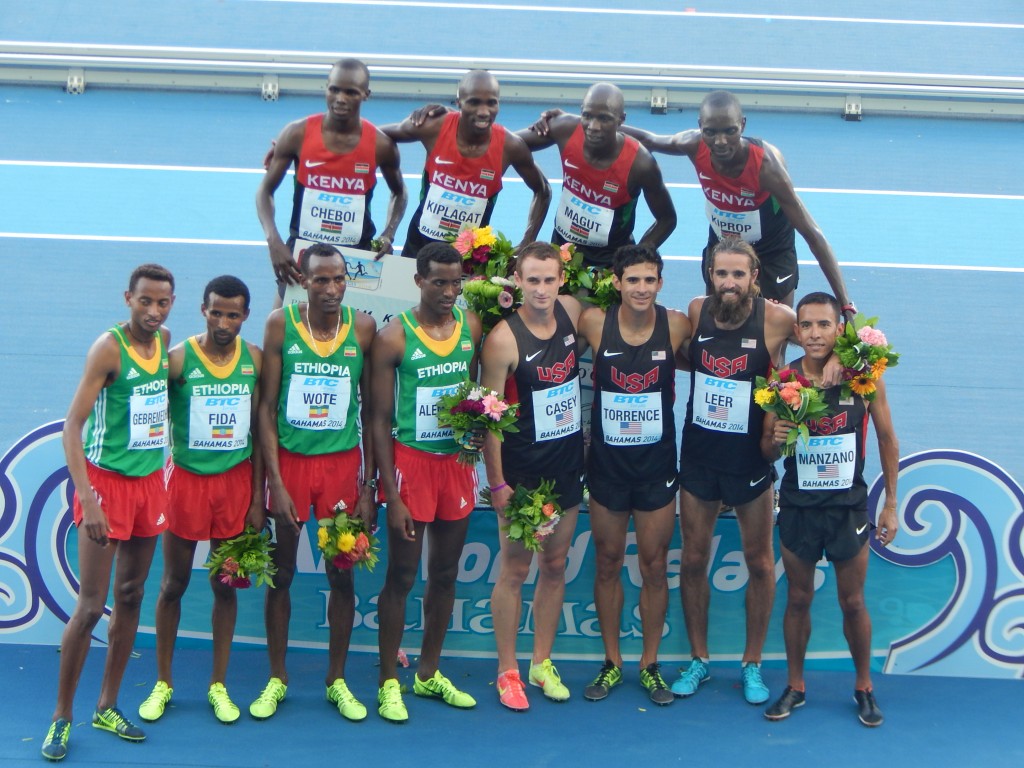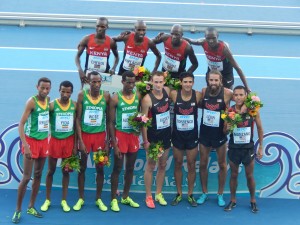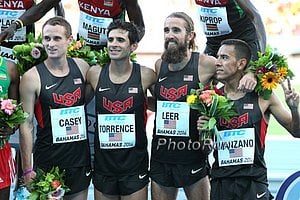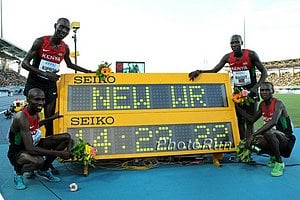Men’s 4 X 1,500 Final: Kenya Gets Gold, US Hangs On For Silver At 2014 World Relays
by: LetsRun.com
May 25, 2014
Nassau, Bahamas – Coming into the World Relays, nearly everyone expected the Kenyans to crush the 4 x 1,500 world record. They did not disappoint.
The Kenyan men pulled away midway through Silas Kiplagat‘s 3:32.5 second leg and never looked back in the 4 x 1,500 at the inaugural World Relays before a festive crowd in Nassau, Bahamas. Olympic and two-time world champion Asbel Kiprop hammered home a solo 3:32.3 anchor leg to power Kenya to victory in 14:22.22, an over 14-second improvement to the previous world record (Kenya averaged 3:35.50 per man).
The U.S. men ran with confidence and actually held the lead after the first leg thanks to a 3:38.2 split by Pat Casey, a late addition to the team. David Torrence ran bravely on leg two and went out hard (53.5 ish for 400) and hung with the Kenyan superstar Silas Kiplagat for most of the second leg. However, once Kiplagat broke Torrence with 200 to go on the second leg, the race for gold was over. Torrence had the fastest split of the night for the US at 3:36.6.
The U.S. still had a big lead in second over Ethiopia and Australia, both after leg two and after Will Leer‘s 3:39.3 leg three, but a poor 3:46.7 final leg by Olympic silver medalist Leo Manzano almost cost the Americans the silver. Manzano was just able to hold off Ethiopia’s Aman Wote, the world indoor silver medalist, in the home straight, crossing in second in a new American record of 14:40.80 (3:40.20 per man, previous record 14:46.30). Ethiopia settled for bronze in 14:41.22, while Australia took fourth in 14:46.04. The top four teams all set national records.
The Race
This race ended up following a similar script to last night’s women’s 4 x 1,500. The first leg had the most drama, as the U.S.’s Pat Casey battled Kenya’s 3:31 man Collins Cheboi and Ethiopian Mekonnen Gebremedhin, seventh at last year’s World Championships.
The pace was decent with Gebremedhin leading through splits of 61.1 and 58.6 for the first two laps. Things picked up on lap three with a 57.7 as Gebremedhin led Cheboi, Casey and Australia’s Ryan Gregson. Casey was hanging tough with the big boys. With 100 to go, racing for the first time in his life outside of the US, Casey went to the lead, and handed off in first with a great leg of 3:38.2. Kenya was second after one leg, with Australia third and Ethiopia fourth.
Kenya’s 2011 world silver medalist Silas Kiplagat clearly viewed this as a problem and ran his first finish-line-to-finish-line 400 in a sizzling 53.5 (the first handoff came the end of the final turn on the track, so this was meters 100-500 for Kiplagat). Think that dropped the field? Think again. Australia dropped off, but the U.S.’s David Torrence did not and neither did Ethiopia’s Soresia Fida. Kiplagat kept flying around the track with a sub-1:50 first 800, and there was David Torrence right with him. Fida cracked after 800m and it was just Torrence keeping with the arguable world #2. With 200 to go in the leg, Kiplagat still led by just 0.3 seconds, but Torrence was beginning to tire as he was on 3:31.7 pace. The last 200m was not pretty at all for Torrence as his form broke down. Kiplagat slowed himself and ran a 29.7, but Torrence was completely cooked, running 33.1. Kiplagat split 3:32.5 to hand off 3.7 seconds ahead of the Americans.
Torrence’s brave early running still earned him a split of 3:36.6 (third-best of the night behind Kiplagat and Kiprop) and gave the U.S. a 2.6-second cushion over Ethiopia in third after the second exchange.
Will Leer ran a solid 3:39.3 third leg for the U.S., and though he couldn’t make up any ground on Kenya’s James Magut (3:38.8 split), his run, coupled with an awful 3:46.5 leg from Ethiopia’s Zebene Alemayehu (PR: 3:33) created a 8.2-second cushion for the U.S. in second.
Everything up front seemed settled at this point. The Olympic champion Kiprop was 4.2 seconds in front and only need a 3:46 for the world record. Behind him the Olympic silver medalist Manzano was nearly 8 seconds up on bronze.
While Kiprop opened up a huge lead up front, Manzano had a rough go of it. Despite no competition, Kiprop still managed to solo a 3:32.3 leg (fastest of the night) to give Kenya the win and a new world record of 14:22.22.
We got splits for Manzano from 300-700 and 700-1,100 on his leg, and they were not encouraging – 61.9 and 62.3. With world indoor silver medalist Aman Wote on anchor, Ethiopia made up a lot of ground, and by the time the runners entered the home stretch for the final time, Wote was within a few meters of Manzano. Manzano had looked strained for much of his leg and he was not taking it easy to secure silver.
That was as close as the Ethiopian would get, however. Despite Wote’s 3:37.3 split, he would have to settle for bronze. Manzano managed to pull together a 58.3 last lap to salvage a poor 3:46.7 leg and prevent Ethiopia from stealing silver.
Results:
 |
1 | KEN | KENYA | Kenya |  KEN KEN |
14:22.22 | WR |
 |
2 | USA | UNITED STATES | United States |  USA USA |
14:40.80 | AR |
 |
3 | ETH | ETHIOPIA | Ethiopia |  ETH ETH |
14:41.22 | NR |
 |
4 | AUS | AUSTRALIA | Australia |  AUS AUS |
14:46.04 | NR |
 |
5 | ESP | SPAIN | Spain |  ESP ESP |
15:00.69 | SB |
 |
6 | POL | POLAND | Poland |  POL POL |
15:05.70 | SB |
 |
7 | QAT | QATAR | Qatar |  QAT QAT |
15:10.77 | NR |
Splits
| Kenya Collins Cheboi 3:38.6 Silas Kiplagat 3:32.5 James Magut 3:38.8 Asbel Kiprop 3:32.3 |
USA Pat Casey 3:38.2 David Torrence 3:36.6 Will Leer 3:39.3 Leo Manzano 3:46.7 |
Ethiopia M. Gebremedhin 3:39.9 Soresa Fida 3:37.5 Z. Alemayehu 3:46.50 Aman Wote 3:37.3 |
Quick Take #1: David Torrence – WOW.
In a relay race with a finish as close as it was for silver, obviously all four legs were critical in the US’s silver medal run. But David Torrence led the way with a BRAVE 3:36.6 run on the second leg, the best US split of the night.
Torrence was pitted versus 3:29.27 man Silas Kiplagat and he didn’t back down. Kiplagat got the baton in second behind Torrence and tried to break it open immediately as Kiplagat went out hard, VERY hard, but Torrence hung right with him.
Torrence ran his first 500 in 66.9. 500 is a weird distance so let’s put that in perspective for you – that’s 53.5 through 400 plus an extra 100 at the same pace.
Torrence’s next 400 (500 to 900) was a 57.1, meaning he went through 800 in roughly 1:49.6. Was Torrence committing suicide?
At this point, Ethiopia’s second leg Foresa Sida backed way off and ran a 62.9 400 to get to 1,300. Torrence just kept going right with Kiplagat. His next 400 was still sub-60, 59.5, meaning his 1,300, not 1,200, split was 3:03.5. At 1,300 meters, Torrence was on 3:31.73 1,500 pace.
Yes, the wheels finally came off for Torrence in the final 200 (33.1), but he still ended up with the best US split of the night and he importantly more than doubled the US’s lead over Ethiopia from 1.7 seconds to 3.6 seconds during his leg.
The GRANDE COJONES AWARD goes to David Torrence.
Afterwards Torrence said he had no idea how fast he was going. He said, “I was just thinking just stick man, just stick as hard as I can to Kenya.”
Once Sida fell off, Torrence started to wonder if he was doing something special. “All I noticed was the Ethiopian fell off. So when they fell off, I was like ‘Are we going fast?,'” David said.
David was animated and excited with his run, but wanted more. “I think we could have hung with them the whole way,” he said if he could have hung on the last 200m. American distance running is definitely at a new level with statements like that.
Torrence said he usually is very conservative in races. “It was definitely uncomfortable. I’m not going to lie.”
Quick Thought #2: Pat Casey showed he more than belonged on this team.
There was some controversy surrounding Pat Casey’s inclusion on the team, but he more than showed he belonged by giving the US the lead on leg #1.
Kenya’s Collins Cheboi has a 3:31.53 PR and already has run 3:32.30 this year, but Casey was better than Cheboi today. Tremendous leadoff leg on Pat’s first trip abroad.
Casey said, “Gags wanted me, so I just believed in him believing me.”
Quick Thought #3: Will Leer’s leg won’t get the attention, but Leer fans can say he was the biggest reason why the US got silver.
Keying off Kenya’s James Magut, who was 3.7 seconds ahead of him to start the leg, Leer only lost .5 of a second to Magut by running 3:39.3. That’s pretty darn good considering Magut has run 3:30.61 already this year.
More importantly, Leer put 7.2 seconds on Ethiopia by splitting 3:39.3 as Ethiopia’s Zebene Alemayehu only managed a 3:46.50.
Quick Thought #4: Leo Manzano wasn’t good at all, but in the end, thanks to a bit of luck and Villanova’s Jordan Williamsz, it doesn’t matter. The US and Leo are wearing silver.
Manzano certainly got the baton in no man’s land. There was no way he was making up 4.2 seconds on the greatest 1,500 runner in the world, Asbel Kiprop, but he was a massive 8.2 seconds up on third (Australian) and 9.8 seconds on fourth (Ethiopia).
But watching Leo run, it was clear to us that he was struggling. This certainly wasn’t a case of someone taking it easy to protect a big lead. He just looked strained.
Leo benefited from the fact that World Indoor silver medalist Aman Wote wasn’t even contemplating silver when he got the stick nearly 10 seconds behind Leo. Wote ran the first 300 fairly quick – 42.1 – to catch up to Australia, which was anchored by Villanova’s Jordan Williamsz. After that, Wote was content to sit behind Williamsz and get ready to blow his doors off over the final 400 (They went 61.3 from 300 to 700 and 59.7 from 700 to 1,100).
Wote did indeed blow the doors off Williamsz on the last lap as one would expect when the World Indoor silver medalist is racing the 8th placer from the NCAA indoor mile (not that Williamsz didn’t run very well here – he split 1:46.3 yesterday in the 4 x 800). Wote ran a 54.2 last lap. Had he known Manzano would run only a 3:46 (and that was with a 58.3 last lap), Wote could have gotten him by going sooner (NCAA fans – it’s worth noting that Williamsz split 3:44.7) as Wote only ended up splitting a modest (by his standards) 3:37.3.
At the end of the day, Leo got the job done. Yesterday, Kenyan anchor Alfred Kipketer celebrated their 4 x 800 gold after nearly blowing it, and we’ve got no problem with Leo and the US doing that here as well. Close doesn’t count in track and field.
What does this mean for Manzano for the rest of 2014? We don’t know but aren’t writing him off. We thought coming in he’d struggle if he ended up running in no man’s land. He’s historically shown he’s NOT a time trialer. This was a time trial type race.
Quick Take #5: What would this have looked like as a 4 x mile? We mentioned how this would have been more interesting from a U.S. fan’s standpoint as a 4 x mile, so we went ahead and converted the Kenyan splits to a mile (multiplied by 1.08) and listed them below. We’ve done the same for the U.S. These aren’t meant to be definite conversions, but they give a rough idea of how a 4 x mile might have looked.
Kenya
Collins Cheboi 3:56.1
Silas Kiplagat 3:49.5
James Magut 3:56.3
Asbel Kiprop 3:49.3
Total time: 15:31.2 (average 3:52.8)
USA
Pat Casey 3:55.7
David Torrence 3:53.9
Will Leer 3:56.8
Leo Manzano 4:04.8
Total time: 15:51.3 (average: 3:57.8)
For comparison’s sake, the current world record is 15:49.08 by Ireland while the American record is 16:08.54.
Quick Take #6: Kenya delivered a world record as expected.
The opening and third legs for Kenya weren’t very good by Kenyan standards but Kenya still ended up with a win and world record. Not destroying the WR was a good thing … in case there is a $50,000 WR bonus next year.
Watching Kiplagat (3:32.5 leading the whole thing) and Kiprop (3:32.5 all alone) run 3:32s was a lot of fun. The conditions weren’t ideal, either, with some wind on the backstretch.
Kiprop afterwards said the focus this year is on running fast and a possible world record. Up next is the Pre mile, where Kiprop, who has already run 3:29 this year, said he will “see if I’m in good shape.” As for the world record later this year, he said, “I’m looking forward to trying to run 3:26 and I believe it is achievable.”
Quick Take #7: Bahrain doesn’t show.
Bahrain was on the initial entry list with a team featuring drug cheat Rashid Ramzi and 2009 world 1,500 champ Yusuf Saad Kamel, who has been largely invisible over the past few years. It seemed odd that these two would suddenly emerge together for a race like this, so it’s no surprise that Bahrain ended up scratching from this race.
Flash Interviews:
Asbel Kiprop Next Will Target 1,500 WR:
World, Meet Pat Casey:
It was Casey’s first trip outside of the US and he delivered.
Leo Gets The US Silver:
Leo loved the team environment.
David Torrence After Hanging With Kiplagat:
Will Leer:
 4 x 1,500 medalists (check back Monday for a photo gallery).
4 x 1,500 medalists (check back Monday for a photo gallery).











